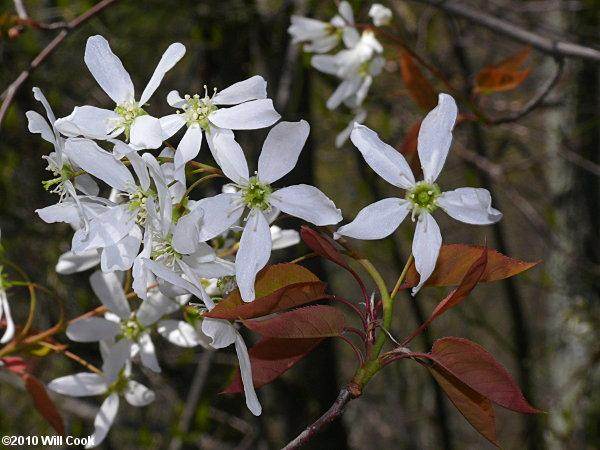




With forty shades of green, it's hard to be blue.
Garg 'nuair dhùisgear! Virtutis Gloria Merces




Seeking a long-term partner to establish forest garden. Keen to find that person and happy to just make some friends. http://www.permies.com/t/50938/singles/Male-Edinburgh-Scotland-seeks-soulmate




With forty shades of green, it's hard to be blue.
Garg 'nuair dhùisgear! Virtutis Gloria Merces
 1
1









 1
1




duane hennon wrote:
based upon the shape of the blossom
i vote for juneberry
https://en.wikipedia.org/wiki/Amelanchier
http://www.eattheweeds.com/amelanchier-arborea-busting-out-all-over-2/
note the leaf shape also, very distinctive
see for comparison
https://en.wikipedia.org/wiki/Cherry_blossom
juneberries are also a very good fruit,
although you may have to shoot the robins to get any

Seeking a long-term partner to establish forest garden. Keen to find that person and happy to just make some friends. http://www.permies.com/t/50938/singles/Male-Edinburgh-Scotland-seeks-soulmate
 1
1




AmberLynn Gairden wrote: Also apples and cherries generally bloom after leafing out.
Seeking a long-term partner to establish forest garden. Keen to find that person and happy to just make some friends. http://www.permies.com/t/50938/singles/Male-Edinburgh-Scotland-seeks-soulmate











Not the ones in my garden. That's one of the reasons I thought Prunus - I do know a few with longer petals.





AmberLynn Gairden wrote:
Not the ones in my garden. That's one of the reasons I thought Prunus - I do know a few with longer petals.
That's why I love this forum. I learn from outside my own experience!
Seeking a long-term partner to establish forest garden. Keen to find that person and happy to just make some friends. http://www.permies.com/t/50938/singles/Male-Edinburgh-Scotland-seeks-soulmate




Seeking a long-term partner to establish forest garden. Keen to find that person and happy to just make some friends. http://www.permies.com/t/50938/singles/Male-Edinburgh-Scotland-seeks-soulmate









With forty shades of green, it's hard to be blue.
Garg 'nuair dhùisgear! Virtutis Gloria Merces

 1
1








With forty shades of green, it's hard to be blue.
Garg 'nuair dhùisgear! Virtutis Gloria Merces
 1
1





 1
1












Bernard Welm wrote:The service berries that I have planted are still quite small and have been flowering and producing berries from year 2. So if you have not had any berries on it in a few years I would say that makes it a bit less likely to be Amalanchier/service berry.




 1
1




Deb Stephens wrote:By the way, someone said they thought that serviceberry leaves came out before the blooms, but that is not the case. Both serviceberry and wild plums produce flowers first, then leaves. The black cherries (also prunus) are just the opposite, producing leaves before the flowers.
I hope you get some fruits. Ours always get eaten by birdes before we get more than a nibble. They are incredibly delicious but don't taste like blueberries at all (though they do look a lot like them -- except they're red). I personally think they taste like maraschino cherries. They have a kind of cherry/sweet almond flavor.
![Filename: 2012saskatoon5.jpg
Description: [Thumbnail for 2012saskatoon5.jpg]](/t/54963/a/38333/2012saskatoon5.jpg)
Vic Johanson
"I must Create a System, or be enslaved by another Man's"--William Blake





![Filename: flower1.jpg
Description: Bloom pic from Va Tech website [Thumbnail for flower1.jpg]](/t/54963/a/38337/flower1.jpg)
With forty shades of green, it's hard to be blue.
Garg 'nuair dhùisgear! Virtutis Gloria Merces




With forty shades of green, it's hard to be blue.
Garg 'nuair dhùisgear! Virtutis Gloria Merces




Victor Johanson wrote:
The ones around here (Amelanchier alnifolia) always have leaves on them before the blossoms open, and they're dark purple, like blueberries.
 2
2




Karen Layne wrote:All of the pictures i had seen showed green leaves so i assumed mine were damaged by the frost, but i just noticed that the leaves in the picture posted by Rue Barbie (1 wk ago) are also reddish.




 Just like yours. I also hadn't realised there are so many different Amelanchiers! What a lovely species
Just like yours. I also hadn't realised there are so many different Amelanchiers! What a lovely species 




With forty shades of green, it's hard to be blue.
Garg 'nuair dhùisgear! Virtutis Gloria Merces




Deb Stephens wrote:
Karen Layne wrote:All of the pictures i had seen showed green leaves so i assumed mine were damaged by the frost, but i just noticed that the leaves in the picture posted by Rue Barbie (1 wk ago) are also reddish.
Some of the young leaves of the serviceberries I see around here do start out red but turn green as they mature. I'm not sure if any other varieties stay red though.
Vic Johanson
"I must Create a System, or be enslaved by another Man's"--William Blake




Deb Stephens wrote:
Victor Johanson wrote:
The ones around here (Amelanchier alnifolia) always have leaves on them before the blossoms open, and they're dark purple, like blueberries.
I stand corrected. I am so used to the common serviceberry trees we have around here that it didn't occur to me that other species might be that different. I also didn't realize there were so many species until we started this discussion -- wow! I'm seriously looking into getting some of those large-fruited bush varieties.
Vic Johanson
"I must Create a System, or be enslaved by another Man's"--William Blake
 1
1




With forty shades of green, it's hard to be blue.
Garg 'nuair dhùisgear! Virtutis Gloria Merces

|
A day job? In an office? My worst nightmare! Comfort me tiny ad!
Homestead Pigs Course
https://permies.com/wiki/365748/Homestead-Pigs
|






